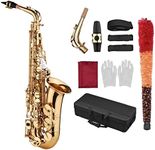Buying Guide for the Best Alto Saxophones
Choosing the right alto saxophone can greatly enhance your playing experience, whether you're a beginner or an experienced musician. The key is to find an instrument that matches your skill level, playing style, and personal preferences. Consider the material, build quality, and sound characteristics, as these will influence the saxophone's performance and your satisfaction with it. It's also important to try out different models if possible, as the feel and sound can vary significantly between them.MaterialAlto saxophones are typically made from brass, but the finish can vary, including lacquer, silver plating, or gold plating. The material and finish can affect the instrument's sound and appearance. Lacquered brass is common and offers a warm sound, while silver plating can provide a brighter tone. Gold plating is often used for its aesthetic appeal and can offer a richer sound. Consider what sound quality you prefer and how much maintenance you're willing to perform, as some finishes require more care.
Build QualityThe build quality of an alto saxophone affects its durability and playability. High-quality instruments are typically more robust and have better key mechanisms, which can improve your playing experience. Look for saxophones with smooth key action and solid construction. Beginners might opt for a more affordable model with decent build quality, while advanced players may prefer a professional-grade instrument that offers superior craftsmanship and longevity.
SoundThe sound of an alto saxophone is a crucial factor, as it defines the instrument's character and your personal expression. Sound can vary based on the saxophone's design, material, and even the mouthpiece and reed used. Beginners should look for a saxophone with a balanced, easy-to-produce sound, while more experienced players might seek a specific tonal quality, such as a brighter or darker sound, to suit their musical style.
ErgonomicsErgonomics refers to how comfortable the saxophone is to hold and play. This is important because a well-designed instrument can prevent fatigue and allow for better technique. Consider the weight and key layout of the saxophone. Beginners should look for a model that feels comfortable and easy to handle, while advanced players might prioritize a saxophone that allows for more nuanced control and expression.
IntonationIntonation is the ability of the saxophone to play in tune across its range. Good intonation is essential for playing with other musicians and achieving a pleasing sound. Test the saxophone's intonation by playing scales and checking for consistency in pitch. Beginners should choose a saxophone with reliable intonation to help develop their ear, while advanced players might look for an instrument that offers precise tuning adjustments.














